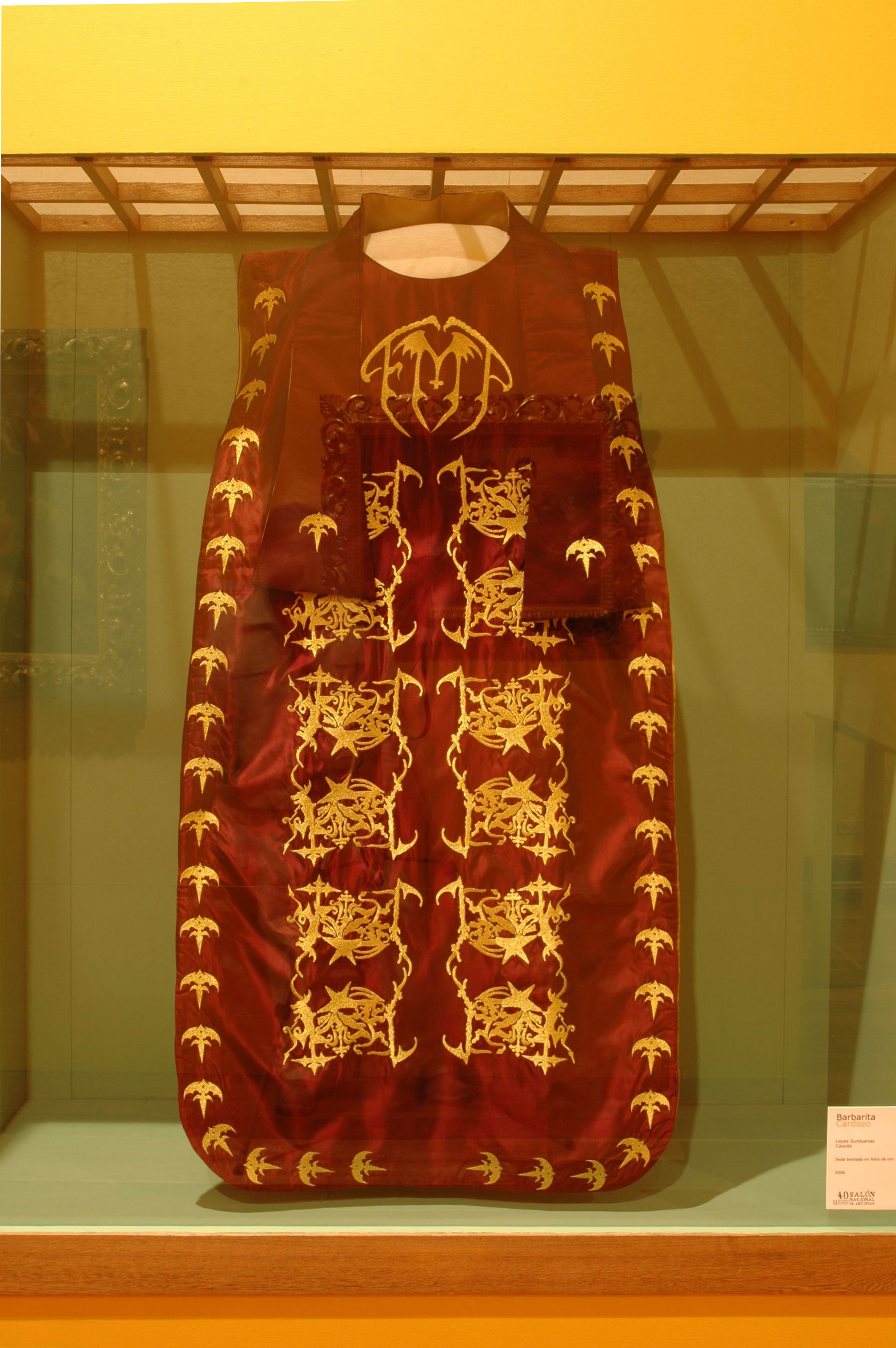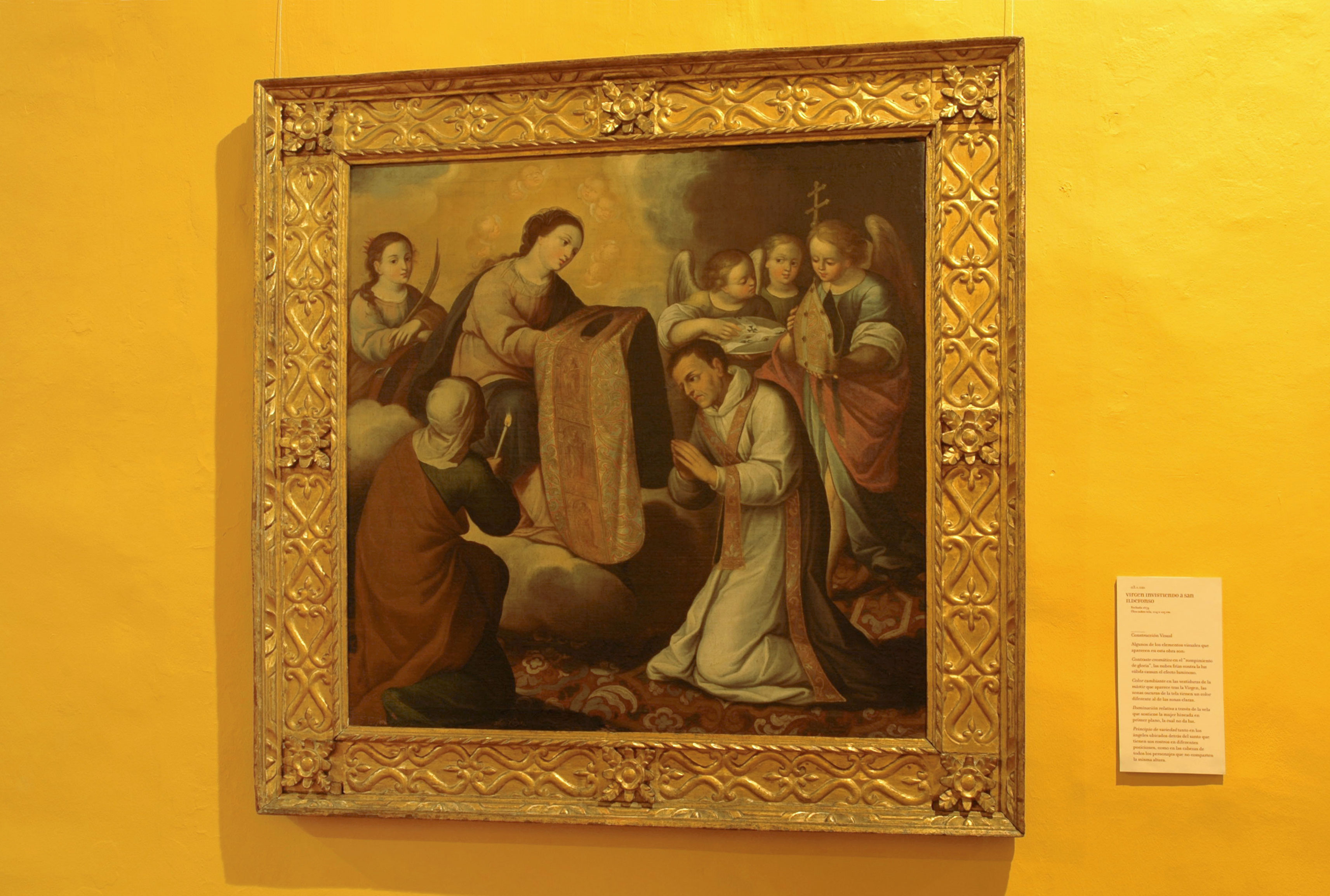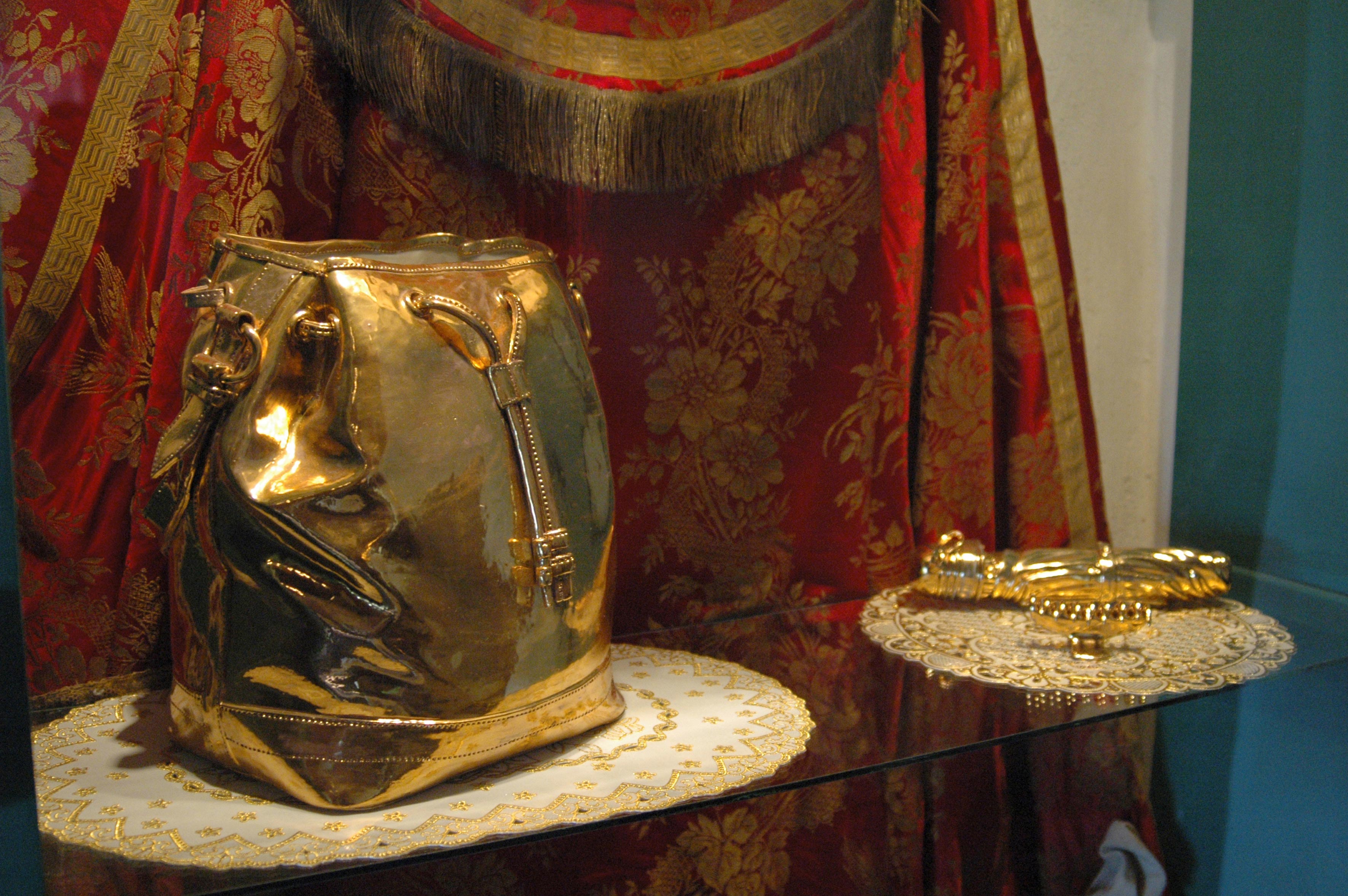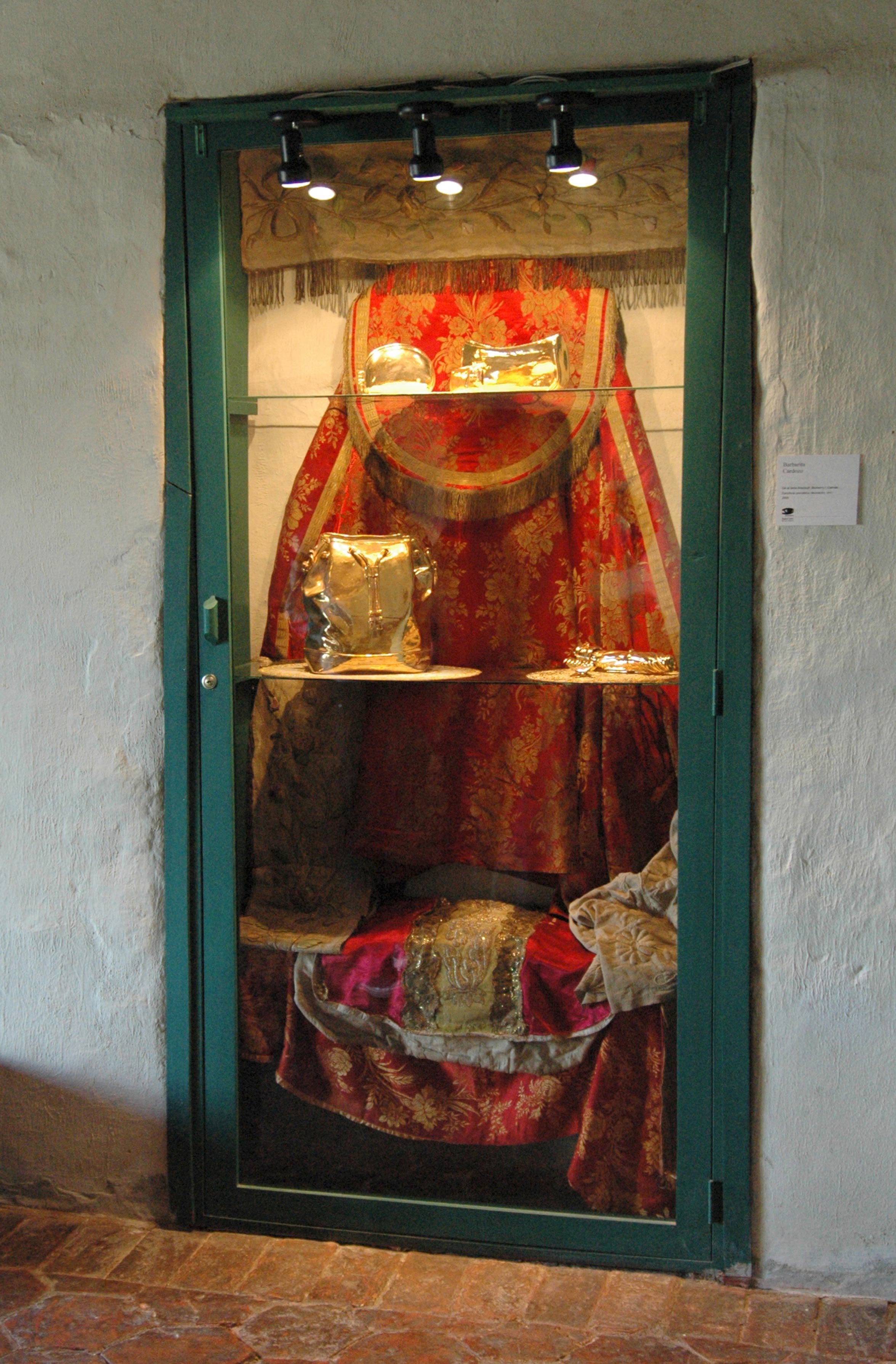LEYES SUNTUARIAS
A fines del año pasado en La Casa del Escribano Don Juan de Vargas en Tunja, Natalia Gutiérrez monta algunas de las porcelanas de la serie Knock Off (presentada inicialmente en la Galería Casas-Reigner) de Barbarita Cardozo, como parte de su curaduría para el Salón Regional Sede Centro. Porcelanas doradas que semejan accesorios de Versace, Dior y Luis Vuitton se exhibieron dentro de una vitrina de la casa-museo acompañadas entre otras antigüedades por una capa pluvial preciosamente adornada con bordados en hilo dorado. Esa acompañante inesperada pero bienvenida, es el origen de la nueva serie de Cardozo: Leyes suntuarias.
Las Leyes Suntuarias aparecen en el siglo III d.C. en Roma, limitando el uso de joyas, telas preciosas como la seda, hilos de plata y oro y ciertos colores como el púrpura, únicamente en vestidos y accesorios religiosos. Diez siglos después la ley cobija también a la monarquía, señalando el vínculo entre estos dos poderes. Una vez más el núcleo del proyecto es el lujo, exhibido en prendas de vestir y accesorios, como representación de poder. Pero si en Knock Off es el poder adquisitivo (y el gusto) de la clase alta lo que se pone en juego en las copias de objetos decorativos (como monumentos a escala de sus referentes) cuyos originales importados poseen altísimo valor; en esta nueva serie el poder en cuestión es el de la Iglesia. Barbarita Cardozo toma los moldes de trajes religiosos de la época de La Colonia como casullas, capas pluviales y mitras para construirlas en sedas y terciopelos y decorarlas con bordados en hilo de oro y plata, y aquí aparece el desvío: los motivos de los nuevos bordados ya no son plantas de vid, ni palomas, ni soles; ahora los barrocos decorados se componen de logos y símbolos tomados de discos de grupos de Dark Metal o de Heavy (Asphyx, Desecrator, Queensrÿche, Opeth…). La inserción de estas particulares «marquillas», presumiblemente satánicas y oscuras, en clásicas y lujosas prendas de vestir sacramentales, ejemplifica, una vez más, las motivaciones de la joven artista colombiana: el pirataje, la apropiación de estilos y logos, el lujo, la moda, la representación y la simulación; pero además, y esto es una novedad, es indudable aquí, la crítica al establecimiento religioso. Educada en un colegio franciscano, Barbarita Cardozo memoriza la importancia de la humildad, en un establecimiento pomposo. Este contrasentido se amplifica en las palabras de su tía Antonia, quien desde niña le insistía: «No solo tienes que ser; sino parecer».
En este proyecto, la artista decora el tradicional traje de La Iglesia con símbolos tomados de un mercado supuestamente anti-tradicional, joven, rebelde, profano. Este elemental corto-circuito resultado de unir opuestos (signos de lo profano y lo sacro, signos de lo antiguo y lo joven) evidencia en nuestra incomodidad frente al nuevo objeto, el arrollador culto a la imagen (a lo superficial) en nuestra sociedad y la devastadora confusión entre ser y parecer. El joven metalero, inocentemente quiere ser otro, pareciendo otro, pero es él mismo (un simple comprador de un estilo). Mientras la Iglesia, de manera nada inocente dice ser una pero es otra. ¿El hábito hace al monje?
Humberto Junca
Abril, 2006
—
SUMPTUARY LAWS
At the end of last year, at Don Juan de Vargas Clerk’s House, in the city of Tunja, Natalia Gutiérrez has assembled some of the Knock Off series of porcelains (which were initially exhibited at Casas-Reigner Gallery) from Barbarita Cardozo, as part of her sponsorship for the Regional Artist’s Exhibition of the City Center. Gold-colored porcelains that look like Versace, Dior and Luis Vuitton’s accessories were exhibited in a shop window of the house-museum accompanied among others by a chasuble, beautifully decorated with golden thread embroideries. This unexpected but welcomed companion is the origin of Cardozo’s new series: Sumptuary Laws.
Sumptuary Laws have their origins in the 3rd century AD in Rome, and limited the use of jewels, precious fabrics such as silk, silver and gold threads and certain colors such as purple, only in dresses and religious accessories. Ten centuries later, the law does also rule the monarchy, which indicate the link between these two powers. Once more, the project core is luxury, expressed through dressing clothes and accessories, as a representation of power. But even though in the “Knock Off” work high classes’ purchase power (and taste) is what is put into question by the copies of decorative objects (such as scale monuments of their referents) whose imported originals have a very high value; in this new series, the questioned power is that of the church. Barbarita Cardozo takes models from religious dresses of the Colonial period, such as chasubles, raincoats and miters, to make them in silk and velvet and decorate them with gold and silver thread embroideries. Here we have her differentiation: the motives of the new embroideries are not vines anymore, nor doves or suns; now decorated baroques are made up of achievements and symbols taken from Dark Metal or Heavy Metal records (Asphyx, Desecrator, Queensrÿche, Opeth…). The insertion of these particular “tags”, which are presumably satanic and obscure, in classic and luxurious sacramental garments, exemplifies, once more, the motivations of the young Colombian artist: falsification, appropriation of styles and achievements, luxury, fashion, representation and simulation; but also (this is a novelty, undoubtedly) her criticism to the religious establishment.
Educated in a Franciscan school, Barbarita Cardozo recalls the importance of humanity in a pompous establishment. This contradiction is best explained in the words of her aunt Antonia, who said when she was a child: “It is not only important to be but also to show off”.
In this project, the artist decorates the traditional costume of the Church with symbols taken from symbols of a supposedly anti-traditional, young, rebel, profane market.
This elementary short-circuit resulting from uniting the opposites (signs of the profane and the sacred, signs of the ancient and the young) is evident in our uncomfortable feeling before the new object, the overwhelming cult to the image (and to the superficial) in our society and the devastating confusion between being and showing off. The young man who is a heavy metal fan innocently wants to be different, but he is not (as he is a simple purchaser of a style). In contrast, the Church, says not so innocently that it is one thing, but it is another very different thing. Does clothes make the man?
Humberto Junca
April 2006




